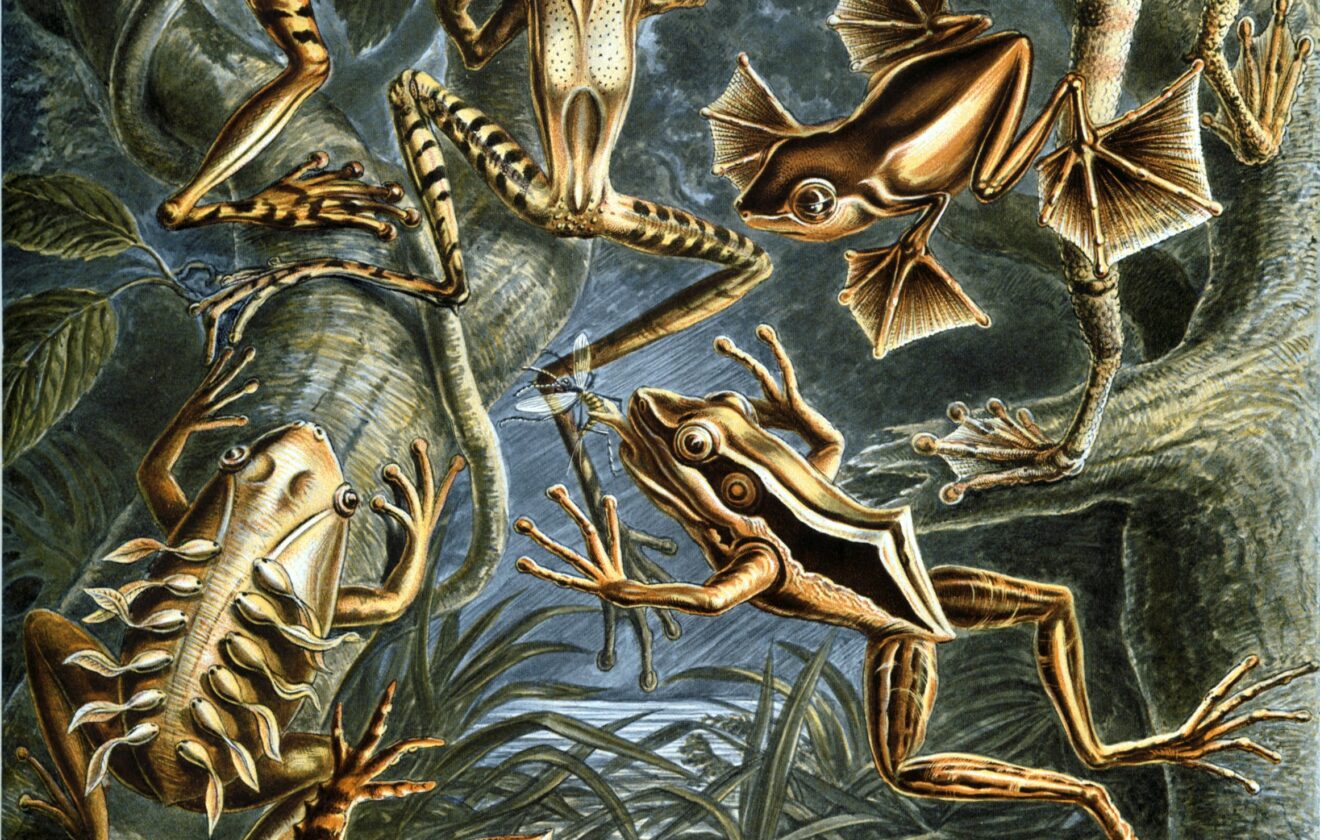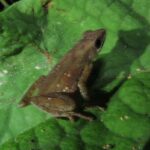- Unearthing the Secrets of the Mozambique Rain Frog (<em>Breviceps mossambicus</em>): An Elusive Gem of Southern Africa
- Taxonomy and Classification
- Natural Habitat: Beneath the Surface of Southern Africa
- Physical Characteristics: A Master of Subterranean Adaptation
- Behavior and Life Cycle: Curious Lives Beneath Our Feet
- The Ecological Role: A Quiet Guardian of Ecosystem Balance
- Threats and Conservation Status: Navigating Uncertain Waters
- Cultural and Scientific Significance: Nature's Subtle Ambassador
- Conclusion: Valuing Nature’s Hidden Creatures
Unearthing the Secrets of the Mozambique Rain Frog (Breviceps mossambicus): An Elusive Gem of Southern Africa#
The forest floor seems silent beneath the veil of moonlight, shadows whispering secrets into the night air. Amid the layers of leaf litter and damp mosses, tucked gently into the earth, lives one of nature’s most remarkable amphibians—the Mozambique rain frog, scientifically named Breviceps mossambicus. Often ignored, not for lack of intrigue but due to its discreet and humble presence, this enigmatic frog species captivates herpetologists, nature enthusiasts, and conservationists alike, cloaked within mystery yet brimming with astonishing adaptations.
Characterized by its unusually rotund body, tiny legs, and an uncanny ability for burrowing, Breviceps mossambicus has earned a special place within the ecological mosaic of southern Africa. With each soft croak and burrowed hideaway awaiting discovery, this small amphibian holds secrets pivotal to understanding our world’s complex tapestry—one fragile thread at a time.
Taxonomy and Classification#
The Mozambique rain frog, Breviceps mossambicus, belongs to the family Brevicipitidae, within the order Anura—commonly known as the frogs. The genus Breviceps, meaning “short-headed,” encapsulates this creature’s distinctly squat figure and disproportionately short limbs designed for subterranean lifestyles.
This fascinating genus comprises multiple species, most sharing a similar inconspicuous lifestyle. Nature’s irony is evident: though its physical presence might suggest insignificance, Breviceps frogs stand as testament to evolutionary adaptation, carefully sculpted through millennia for their burrowing existence. Closely related species, such as the Desert Rain Frog (Breviceps macrops), have gained widespread attention for their peculiar squeaky calls—bringing the entire genus into greater popular awareness.
Natural Habitat: Beneath the Surface of Southern Africa#
Breviceps mossambicus inhabits a relatively narrow but distinct geographical range stretching predominantly along the eastern regions of southern Africa. Found primarily in Mozambique—its namesake—it also populates regions in eastern Zimbabwe, southern Malawi, parts of eastern South Africa, and even reaching into Eswatini territory. While it might appear limited in distribution compared to some of its more cosmopolitan cousins, the precise geographic boundaries only add to its allure and, importantly, highlight its vulnerability.
But it is not just the geography that defines its home; it’s the very essence of the earth itself. Leafy savannah woodlands, sandy coastal forests, and moist grasslands create a brilliant mosaic of ecosystems where B. mossambicus crafts its world beneath ground level. Stepping beneath the towering canopies and descending toward the ground layer, one ventures into the realm of loamy soil, leaf litter, organic debris, and rich, humid earth—precisely the conditions this distinctive amphibian actively seeks.
During periods of rainfall, the Mozambique rain frog emerges from its subterranean burrow. Conversely, in drier spells, it retreats deeper underground, patiently waiting out harsh environmental conditions beneath the soil’s protective embrace. This deep synergy with the ecosystem signifies not just adaptability, but an evolutionary harmony carefully developed through generations.
Physical Characteristics: A Master of Subterranean Adaptation#
A creature of paradoxical charm, Breviceps mossambicus often resembles more of a tiny balloon or a lump of clay than a traditional frog. Small in size—generally no more than 35 millimeters in length—these rotund amphibians display round bodies, short faces, and shortened limbs perfect for efficient digging.
Their coloring, a mixture of browns, grays, and even occasionally tinges of yellows or oranges, provides the perfect camouflage amidst the loose soil, decomposing leaves, and forest floor debris. Unlike arboreal frogs that dazzle with bright shades and vibrant patterns, the muted appearance of the Mozambique rain frog suggests a creature skillfully tuned into a quieter, humbler lifestyle.
Still, beneath this outward simplicity resides sophisticated adaptations. Their short hind limbs exhibit pronounced muscular development, facilitating powerful digging motions, rapidly creating new burrows when danger arises. Its skin, rather thick and slightly granular, retains moisture effectively—allowing this subterranean dweller prolonged survival during dry periods, sustaining itself through selective moisture retention.
Behavior and Life Cycle: Curious Lives Beneath Our Feet#
Breviceps mossambicus lives an existence largely unnoticed by humans, only occasionally brought to our attention by chance discoveries after rain showers. The Mozambique rain frog leads a primarily nocturnal life, emerging from hiding upon higher soil moisture levels. Cautious but curious, these frogs navigate the darkness using finely-tuned sensory capabilities to locate their food, usually consisting of small terrestrial invertebrates like ants, termites, beetles, and larvae.
The Whispering Courtship: Mating Strategies#
Among their many intriguing behaviors, their reproductive strategies stand out prominently. Photographs and studies have documented males inflated into spectacular balloon-like forms during mating calls, dramatically increasing their size and giving off distinctive, plaintive calls that entice females toward their underground or near-surface chambers.
Unlike many amphibians that lay eggs in pools or streams, the Mozambique rain frog bears witness to a unique form of amphibian reproduction. Females deposit small clutches of eggs deep within moisture-rich burrows beneath the soil. There, safely sequestered underground, the eggs hatch directly into froglets, bypassing aquatic tadpole stages—an evolutionary trait fascinating to scientists and advantageous to this highly terrestrial and subterranean lifestyle.
The Ecological Role: A Quiet Guardian of Ecosystem Balance#
Though modest in appearance and elusive by nature, Breviceps mossambicus actively shapes the delicate balance of the ecosystem. Through its diet, it regulates insect populations, indirectly controlling pests and maintaining soil health. It also represents a vital prey species for snakes, birds, and small mammals, anchoring its place securely within the tangled web of an ever-shifting rainforest-like narrative, subtle yet critical.
Acting as an important indicator species, changes within the Mozambique rain frog population reflect primary ecological shifts in habitat quality. A fragile equilibrium defined through this subterranean existence underscores its essential nature in ecological conservation discussions.
Threats and Conservation Status: Navigating Uncertain Waters#
Understanding the threats facing Breviceps mossambicus involves peering into the wider canvas of ecological pressures gripping southern Africa’s struggling wildlife. Habitat loss remains the pre-eminent concern exacerbated by rapid urban expansion, agricultural development, wood extraction, and deforestation within Mozambique and neighboring countries.
Climate fluctuations further influence moisture availability, forcing populations deeper underground and altering mating cycles. Given this species’ reliance on specific moisture-rich environments, even marginal changes in local precipitation patterns threaten their existence profoundly.
Currently, the International Union for Conservation of Nature (IUCN) has classified the Mozambique rain frog as Least Concern, acknowledging its moderately widespread presence despite significant pressures. Nevertheless, ongoing monitoring and research are crucial steps toward maintaining and safeguarding its populations.
Cultural and Scientific Significance: Nature’s Subtle Ambassador#
Beyond pure ecological purposes, Breviceps mossambicus embodies a quieter form of inspiration. Its unique evolutionary traits form an area of active scientific investigation, lending insight to adaptation, development, and survival strategies amid changing climates. Meanwhile, the subtle charm and photogenic appeal of these frogs increasingly captivate amateur naturalists, photographers, and wildlife enthusiasts, instilling curiosity, wonder, and care towards often-overlooked biodiversity.
Conclusion: Valuing Nature’s Hidden Creatures#
In the quiet burrows deep beneath our footsteps, the Mozambique rain frog persists, quietly enriching our natural world through remarkable adaptations, ecological roles, and an extraordinary life history uniquely tailored to subterranean living. Through attention and appreciation of species like Breviceps mossambicus, we illuminate not just the vast richness of Africa’s diverse ecosystems but also remind ourselves of the profound intricacies that bind our natural world together. These humble frogs may be small, but their importance is immense, and their futures entwined intricately with the health of their ecosystems.
Let their quietly fascinating lives inspire a greater stewardship toward safeguarding the delicate tapestry of life beneath our feet. The story of the Mozambique rain frog is still unfolding—let us play our part in ensuring its continued survival, appreciating the smallest wonders of nature more deeply than ever before.








